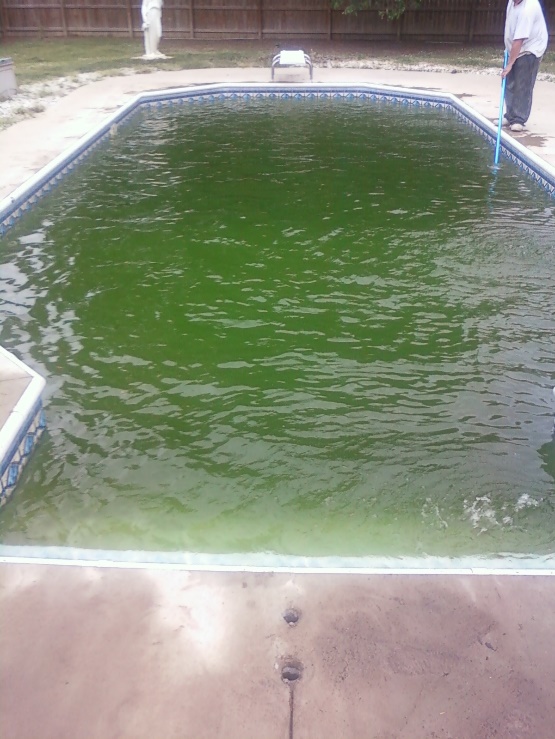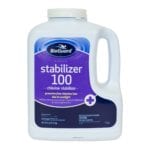Pool Algae
What’s it all about, Pool Algae?
Swimming season is upon us, and it’s time for some straight talk about the #1 problem we hear about from our walk in customers, year after year: POOL ALGAE!
This is a pool with a full algae bloom:
(although it’s not as bad as some we’ve seen!)

Seeing this picture, three problems come to mind:
- No-one wants to swim in a pool that looks like this – although it is not necessarily unsafe to do so.
- An algae problem such as that shown above could be expensive to fix.
- Once you have an algae problem like this – the chances of future problems with algae go up, unless you get your entire system purged of the problem.
So, what the heck is algae anyhow?
Simply put, algae are flowering plants that enter your pool as microscopic spores. They can be wind-blown, brought in by rain, or even by contaminated swimming suits and pool equipment and toys.
Algae spores are always in your pool, but they need 2 things to reproduce and grow and bloom: sunlight (for photo-synthetic purposes) and nitrates and phosphates (for food).
In your pool, poor water chemistry and poor water filtration are the usual suspects as accomplices in any algae bloom. Pool water that is properly balanced and maintained, combined with regular maintenance on your pools systems, surfaces, and equipment will prevent most algae issues. Prevention is key here! Think of your pool as though it was your front yard. It is easier to prevent weeds from growing than it is to pull them out manually! (We’ll talk about prevention and cures a little further on.)
The most common form of algae in our area is green algae. A green algae bloom is often preceded by a “clouding” of the pool, indication poor filtration or sanitation. A full algae bloom, often immediately preceded by a sudden haziness or cloudiness in your pool, can occur in a matter of hours, particularly in hot, sunny weather. Once the bloom is there, the true battle begins!
A pool filled with algae will contribute to the very problems that allowed it to bloom in the first place. It will impede your filtration systems and water flow and it will create chlorine demand and throw your other pool chemistry out of whack! The entire process of fighting an algae bloom can be frustrating, expensive, and time consuming.
HOW TO PREVENT ALGAE IN YOUR SWIMMING POOL:
The first step in preventing algae is proper maintenance of your pool water chemistry and equipment (see our blog on these topics here!) In addition to the equipment and chemical routines outlined in that blog, please remember the following:
- Algae spores cannot reproduce in properly maintained water. Besides making certain that your sanitizer and PH levels are in range at all times, you should know that a pool water stabilizer will help you maintain those levels and can save you money on sanitizer and pH increasers or decreasers in the long run.
- Algae’s favorite food sources are nitrates and phosphates. These elements come from our bodies, rainfall, our lawns, leaves and grass clippings, and many other sources. Nitrates and phosphates can be controlled with Pool Perfect and PhosFree, an enzyme based product that will keep these levels at near zero.
- A preventative algaecide, such as Bioguard’s Back-Up should also be part of your algae prevention routine.
POOL ALGAE INTERVENTION:
Sometimes, stuff happens, and even our preventative plans fail: We have unusually long or heavy rains. Our lives get in the way, and we ignore the pool chemistry for a while. We have a week of really hot weather and really high pool usage. Suddenly, we have algae! What now????
Test the water! Adjust the Ph first! Sanitizers are most effective when your Ph is between 7.1 and 7.3.
Check your equipment! Clean your baskets. Backwash your filter for slightly longer than normal. If the weather and your water are warm, you might want to shut off your heater. (Remember: Algae love warmth!)
Brush your pool thoroughly. Pool algae grows on the sides, the walls, ladders, steps, returns, etc. You will need to brush aggressively to make sure you release the algae so your water treatment is more effective. Pay attention to areas with lower circulation (corners and around fittings, skimmers, returns and drains.)
Shock the Pool! Shock it heavily. Algae can survive in high levels of chlorine well above 15 ppm. You need to hit it with the big guns. Add a polymer or metal based algaecide. Run your filter continuously.
Test your water the next day again. If your sanitizer levels are still quite high, continue frequent brushing and backwashing. Pay attention to the pool corners and seams.
If you are showing little or no sanitizer, it means the algae is winning. You will need to shock the pool again! We recommend running your pool cleaner to keep the water stirred up.
Sometimes, we suggest tossing in all your pool toys and equipment and hand-scrubbing ladders and railing and the undersides of steps and boards.
Once your algae issue is under control, restart your regular maintenance program, paying particular attention to sanitizer and pH levels. We advise using a filter cleaner to help flush your system of the algae you have beaten. (image?) As mentioned earlier, algae spores are always in your pool, waiting for your vigilance to waver. They will come back if you let your guard down.
As you can see from these instructions, there is no real quick-fix for a major algae outbreak. But with the right tools, chemicals and diligent attention, as well as the expert advice of the staff at Continental Pool and Spa, you can beat even the most stubborn, persistent algae problem. For questions about this blog, about algae problems not described here (yes, there are other even more stubborn forms of algae to think about!) please stop in the store or give us a call at 402-333-9025. If you would like us to come out and help you battle the algae, contact our service department to schedule!





Nobody wants a pool with algae, so thank you for educating us.
Thanks for the info on algae. I’m dealing with it right now. I’m struggling a bit with getting my ph levels down. Is it OK to use muriatic acid to lower my ph levels?